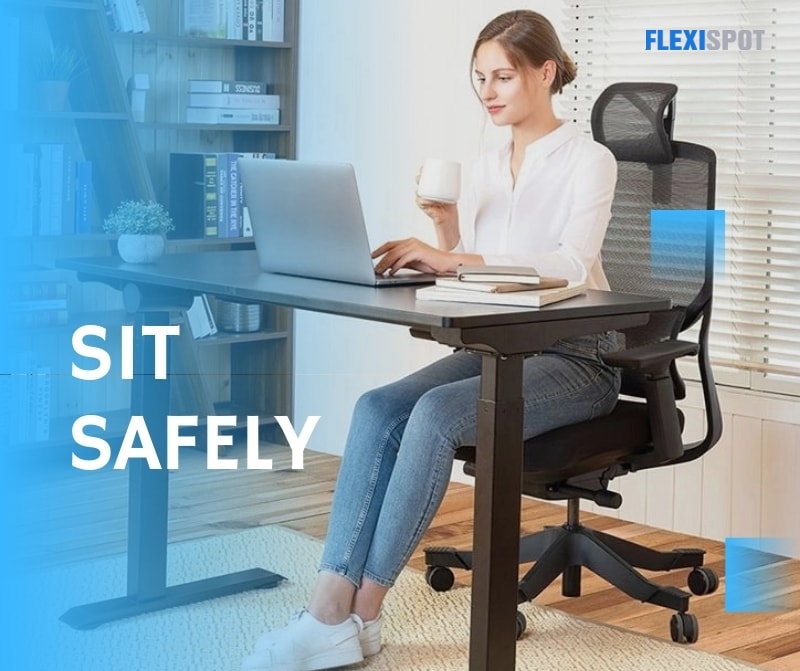Many professional workplaces have workstation policies. You can always inquire about alternate, more ergonomic chairs, and desks or even bringing your own to the workplace. You might also go all out and ask about the latest health-promoting workplace equipment, such as a height-adjustable desk or treadmill desk. But don't be dismayed if you get a negative response.
There is mounting evidence that a sedentary lifestyle characterized by prolonged sitting is detrimental to the spine and overall health. We rarely consider our office chair when we consider the items that could endanger our lives. However, many scientists claim that your office chair is one of the possible hazards to your health. According to studies, you can lower your risk of type 2 diabetes, cardiovascular disease, cancer, and back discomfort by making one easy lifestyle change: sitting less.
It's pretty simple to set up your workstation to reduce neck and back discomfort. Workplace equipment such as ergonomic chairs and height-adjustable standing desks make it much more convenient than ever before to conclude the day pain-free. Furthermore, considering your workspace is an excellent time to review your posture and other positive workplace practices.
What Can You Do?
It's easier than you think to establish your workspace to prevent unwanted back and neck discomfort. Begin by sitting in your chair with proper posture, facing straight. Create the work environment surrounding you while sitting. To put it another way, arrange each piece of equipment and accessory to accommodate your ideal posture. To elevate your screen to eye level, you may need to stack some books underneath it. Perhaps a sliding keyboard tray will make typing less unpleasant -, and this is something you can simply get without the manager's permission.
PICK THE PROPER CHAIR
You should sit in a well-designed ergonomic chair to minimize fatigue and discomfort, promote blood circulation, and lower the chance of neck and back injury. Your workplace chair should preferably:
Recline
Make sure it has a sturdy backrest with lumbar support
Swivel or rotate to make it easier to transfer from one task to another
Allow your feet to be completely flat on the ground
Getting the appropriate chair is crucial; therefore this is one thing that should be experienced in person rather than purchased online to get a sense of how it feels. While getting the proper chair is vital for avoiding back discomfort, taking regular breaks to stretch your legs and roll out your shoulders is also important. Get up every hour for a drink of water and some good body stretches while you're at it.
SIT SAFELY
Even if you have the best gear, your back will hurt if you don't sit properly. Pay attention to the position of your head, hands, and legs while sitting. If you want to avoid back problems, make sure you do the following:
Sit up straight, with your shoulders and back against the chair's back. Make sure you're not slouching.
Do not hold your phone between your head and shoulder. Consider utilizing a hands-free headset to avoid neck and shoulder problems if you spend so much time on the phone.
To avoid circulation difficulties or nerve pressure, place your arms comfortably on the armrests.
While typing, keep your shoulders relaxed.
Crossing your legs is not a good idea.
CHECK HOW YOU WORK ON YOUR COMPUTER
The ideal position for your work screen is just below or at eye level. This will keep your shoulders relaxed, your neck stretched, and your head from tugging on your neck muscles. Consider the following suggestions:
Consider the following suggestions.
To improve wrist alignment, slant the keyboard downwards and away from you.
Make sure your mouse is close enough to your body so that you can control it without moving your arms.
To prevent eye and neck strain, position the monitor straight across from you at eye level, not off to aside.
Consider buying an external display or keyboard and mouse if you're using a laptop. This will help you to move every one of these components independently to achieve a comfortable setup.
THE FUNCTIONAL DESK
The best method is to alternate between sitting and standing throughout the day and, as well as some desks—known as sit-stand desksor height-adjustable desks—encourage you to do so. From learning in school to working behind a desk as adults, we are accustomed to sitting while working. With standing or height-adjustable desks, there is now a new way of addressing deskwork. Standing desks allow us to shift positions throughout the day while spreading pressure and weight evenly over our neck, spine, pelvis, and legs.
If you choose to stick to your regular desk, for now, make sure:
At a height of 28′′ to 30′′ above the floor
Steady and not shaking or wobbling
Big enough to fit your computer and provides plenty of room for writing and other tasks, but not too big that you have to lean over to do your duty, which puts too much strain on your back.
Final Thought
The impact of sitting on our spines can be reduced by creating the optimum workstation, which includes the right chair, desk, and computer setup, as well as proper sitting habits and regular breaks. If you've been sitting at your desk for a long time, you're likely to have back pain constantly. If this is the case, a chiropractor appointment may help. Using the suggestions above for your workstation, as well as consulting a chiropractor, will make those long shifts at your workstation pain-free, at least physically.



